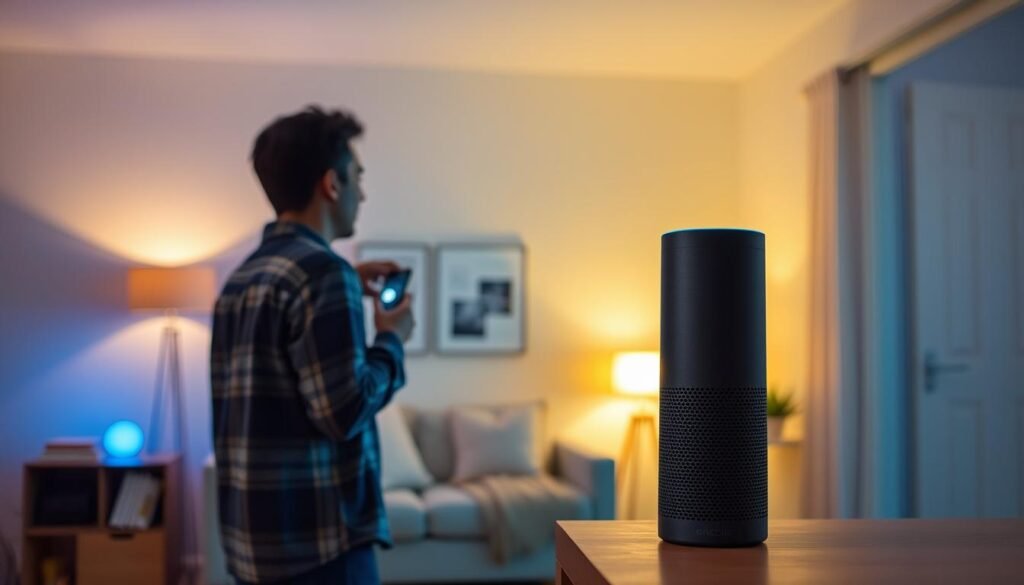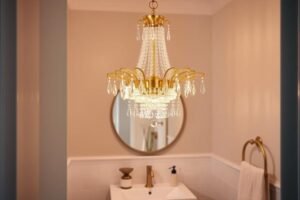Picture this: It’s a warm summer evening, and you’re sitting on your porch, sipping a cool drink and gazing up at the starry night sky. The soft glow of the lights around you creates a comforting ambiance, making you feel at peace. Now, imagine being able to control those lights with just a simple voice command or a tap on your smartphone. Sounds futuristic, doesn’t it?
Welcome to the world of smart light bulbs, where technology and illumination come together to create a truly magical experience for your home. In this article, we will explore the fascinating world of smart bulbs, diving into how they work and the incredible features they offer.
Key Takeaways:
- Discover the revolutionary technology behind smart bulbs
- Learn how LEDs make smart bulbs energy-efficient and long-lasting
- Explore the communication capabilities of smart lights for effortless control
- Understand the different bulb shapes and sockets to fit your lighting fixtures
- Uncover the numerous benefits smart bulbs bring to your home
How do LEDs work?
Light-emitting diodes (LEDs) are at the heart of smart light bulbs. These innovative bulbs utilize LED technology, which is the key to their unique features and functionality. LEDs work by transferring electricity through a semiconductor material, allowing them to produce light with minimal heat emission. Unlike traditional incandescent bulbs, LEDs are highly energy-efficient, requiring only a fraction of the electricity to generate the same amount of light.
LEDs are small, solid-state devices that convert electrical energy into light through a process called electroluminescence. When an electric current passes through the semiconductor material in an LED, it emits photons, which are the particles of light. The specific composition of the semiconductor determines the color of the light produced.
One of the main advantages of LED technology is its energy efficiency. LEDs convert most of the electrical energy into light, while traditional bulbs waste a significant portion of energy as heat. This efficiency makes LEDs an ideal choice for smart lighting solutions, as they consume less power and last much longer than incandescent or fluorescent bulbs. Additionally, LEDs are durable and resistant to the effects of frequent switching on and off, making them a reliable lighting option.
Moreover, smart light bulbs with LED technology offer a range of features that enhance their functionality. These bulbs can be dimmed or brightened, allowing you to create the perfect ambiance for any occasion. Many smart bulbs also offer adjustable color temperature, enabling you to customize the lighting to suit your preferences or set the right mood in different areas of your home. With smart bulb technology, you can control your lights remotely through smartphone apps or voice commands, bringing convenience and flexibility to your lighting experience.
Overall, LEDs play a crucial role in the operation of smart light bulbs, offering energy efficiency, durability, and versatile features. Their innovative design and advanced functionality have revolutionized the way we illuminate our homes, providing efficient and customizable lighting solutions for a more comfortable and connected living environment.
How do smart bulbs work and communicate?
Communication is a key aspect of smart lights. These bulbs can connect to the internet and communicate with your smartphone or other smart devices, allowing for seamless control and automation of your lighting. But how exactly do they do that?
Smart lights utilize various wireless standards to establish communication. The most common ones are Wi-Fi and Bluetooth, which enable the bulbs to connect directly to your Wi-Fi router or to a secondary wireless hub. This hub acts as a bridge between your smart bulbs and your smartphone or other smart devices, relaying commands and enabling automation.
With voice control lighting, you can take control of your smart lights using simple voice commands. By integrating your smart lights with virtual assistants like Amazon Alexa or Google Assistant, you can dim the lights, change colors, or turn them on and off, all with just your voice.

But it doesn’t stop there. Smart lights are an integral part of the Internet of Things (IoT) lighting systems, contributing to the overall functionality of your smart home. These connected lighting solutions can adapt to your needs, taking into account factors like sunrise/sunset times and your phone’s location to automatically adjust the lighting accordingly. This level of automation enhances convenience and energy efficiency in your home.
In the realm of smart home automation, smart lights play a vital role. They can be programmed to turn on and off at specific times, creating a welcoming ambiance when you arrive home or deterring potential intruders when you’re away. With programmable LED lights, you have full control over the atmosphere of your living space.
By embracing smart home automation and Internet of Things lighting, you can elevate your home’s lighting experience to a whole new level. Say goodbye to traditional light switches and hello to the future of illumination.
Bulb shapes and sockets
When it comes to installing smart bulbs, it’s crucial to consider the different bulb shapes and sockets available. Smart light bulbs are designed to fit various fixtures and lamps, ensuring a seamless integration with your existing lighting setup. By understanding the different options, you can choose the right programmable LED lights for your connected lighting solutions.
One of the most common bulb shapes is the A-class bulb, which is compatible with standard fixtures found in most homes. These versatile bulbs are a great choice for general lighting throughout your space. Whether you need to illuminate your living room, bedroom, or kitchen, A-class bulbs provide the perfect solution for installing smart bulbs.
For those looking to enhance their vanity mirrors or bathroom lighting, G-class bulbs are an excellent option. These rounder bulbs offer a flattering and evenly distributed light, making them ideal for grooming and makeup application. With programmable LED lights, you can customize the lighting conditions to achieve the perfect ambiance in your bathroom or dressing area.
If you’re aiming for a more decorative lighting setup, consider B- and C-class bulbs. These conical and highly stylized bulbs are perfect for accentuating specific areas of your home or adding a touch of sophistication to your interior design. Whether you want to highlight artwork on your walls or create a cozy atmosphere in your reading nook, these decorative bulbs offer endless possibilities for customization.
When it comes to recessed light fixtures, BR-class and PAR-style bulbs are the go-to options. These bulbs are designed to fit seamlessly into recessed ceiling or wall fixtures, providing focused and directional lighting. Whether you’re illuminating a hallway, showcasing a collection, or accentuating architectural features, these programmable LED lights offer precise control over your lighting arrangement.
If you have track lighting fixtures in your home, you’ll want to opt for MR bulbs with pins. These bulbs are specifically designed to be secured onto track lighting systems, allowing you to adjust and position the lights according to your preferences. Whether you’re highlighting specific areas, illuminating a workspace, or creating a dynamic lighting display, MR bulbs offer flexibility and ease of installation.
Carefully Choose Based on Context
When selecting smart light bulbs, it’s essential to consider the context in which they will be used. Each bulb shape and socket type offers distinct functionalities and advantages, ensuring that you find the perfect match for your lighting needs. By installing smart bulbs that are specifically designed for your fixtures, you can enjoy the full potential of connected lighting solutions in your home.
Conclusion
Upgrade your home lighting with smart bulbs and unlock a whole new world of illumination possibilities. Smart light bulbs offer numerous benefits that go beyond traditional lighting options. Not only do they provide energy-efficient lighting, reducing electricity consumption and saving money on utility bills, but they also offer convenience and comfort through easy control and automation.
With smart lighting systems, you can effortlessly adjust the brightness and color of your lights to create the perfect ambiance for any occasion. Whether you want a warm and cozy atmosphere for movie nights or a vibrant and lively setting for parties, smart bulbs can cater to your preferences and transform your living space.
Furthermore, the integration of smart bulbs with IoT technology ensures seamless connectivity and opens up a world of possibilities. Imagine controlling your lights with just your voice, using devices like Amazon Alexa or Google Assistant. With the power of your voice, you can effortlessly turn on/off lights, dim them, or even change colors to suit your mood. It’s truly a hands-free lighting experience.
Experience the future of illumination with energy-efficient lighting solutions and embrace the benefits of smart bulbs. Not only will you enjoy enhanced comfort and convenience, but you’ll also contribute to a more sustainable and eco-friendly lifestyle. Upgrade your home lighting today and make every moment shine with the brilliance of smart bulbs.




